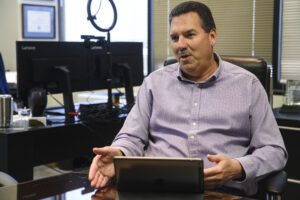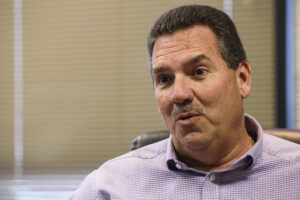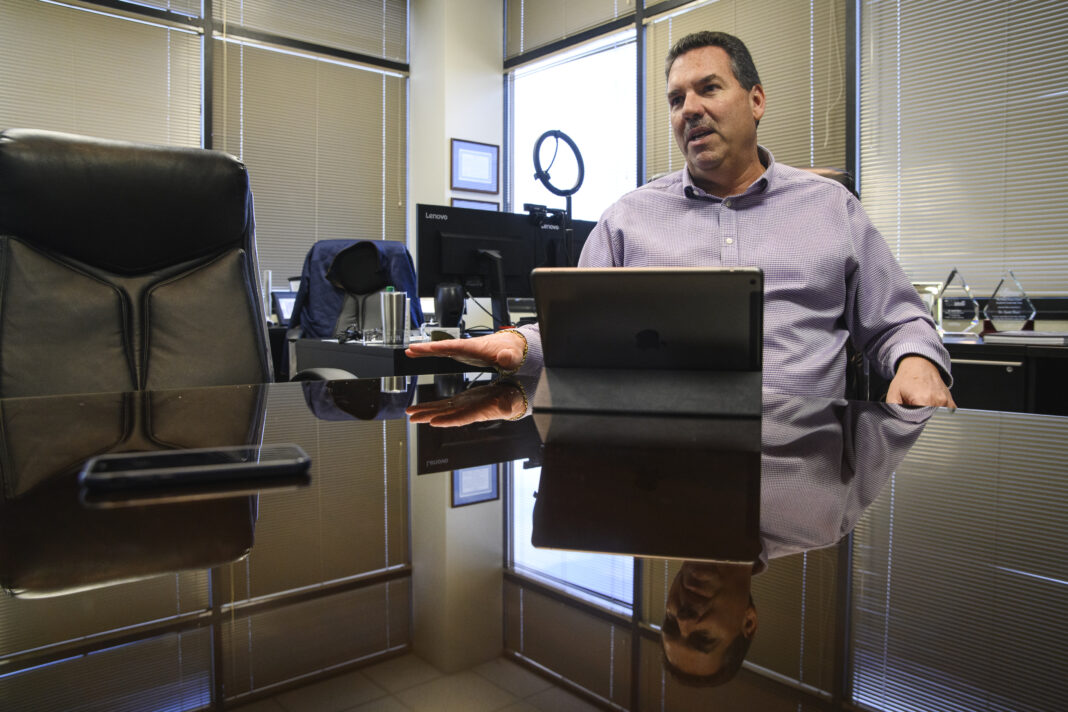While Ector County ISD may not be at the level it would like, Superintendent Scott Muri says good things are happening in the district.
In his State of the District address earlier in March, Muri said kindergarten readiness has increased by 13 percentage points, SAT scores were above the state level and there was a 7 percent increase this year over last in college, career and military readiness. This is a factor in state accountability standards.
“We are now above the region and we are now tied with the state of Texas … What that says to us is our students in ECISD coming from our five high schools are just as prepared as every other student in the state of Texas,” Muri said.
He noted that the 84.7 percent graduation rate is the highest in 20 years.
Muri said he’s not sure why college, career and military readiness have increased and would have to dig more deeply to understand it.
He added that it covers going to a two or four-year college, technical school, or the military. “… Those data are generated from a variety of different things students do — everything from courses in which they engage to SAT scores to graduation rates. There’s a lot of factors that influence CCMR, so I’d have to understand exactly what happened in the state to know why theirs dropped,” Muri said.
“But broadly, there were many schools in Texas in which kids were not attending school for many, many months. And remember, we in August of 2020, we started going back to school, so we have kids from the first day of school and then we phased in and not every district in Texas did that. Many were out for months. That affected kids and we’ve seen that. We were fortunate that we were able to start when we did. Our kids have benefited because of that,” he added. Muri said two and a half years ago, the district was at 56 percent. It is now at 63 percent in college, career and military readiness, which is part of measuring college readiness. It is the percentage of high school students that are prepared for postsecondary success.

“When you think about it in the state of Texas, 70% of our jobs require some form of postsecondary credential. And 63 is not 70. So even though we feel good because we’ve increased by 7%, we’re still not where we need to be based upon the job market in our state. So if somebody says, the state is still bad. Well, yeah, we’re below where we should be; absolutely as a state because the state’s at 63, as well,” Muri said. The goal of the ECISD Board of Trustees is to reach 65% by 2024 and they are at 63%. “(I’m) pretty confident we’re gonna hit the 65 by 2024, so that’s good. So we have been real pleased with that,” Muri said.
Many times when a high school student receives a diploma at graduation, districts are “done with them.”
“In ECISD, that just can’t be the case. We have to make sure that our kids continue to be successful. We created a new department called the To and Through Department, and the to is getting our kids to that next step. So to college, to the military, to a technical (school), but then through it. We recognize that while some of our kids get to, many of them didn’t make it through. And sometimes they, at the end of that first semester, they run out of money, and they’re not sure where to get more money, so they just come home. Or it’s hard. Postsecondary college is hard. Technical school can be difficult. Sometimes you pick up the phone and call home. And if … you’re calling a family that perhaps hasn’t had a postsecondary experience themselves, they may not know how to advise you. And so today we now have, instead of calling home, you could actually call ECISD while you’re a freshman in college or a sophomore in college, and we can give you some advice on perhaps where you could find additional funds to continue your education, or if you’re having a rough time struggling with your academic studies, where you could go on your campus to find support; how to find a tutor, etc. Kind of give kids the encouragement that they need to make it through that postsecondary experience. So that’s the office of To and Through — all about supporting our graduates, our alumni if you will, in their journey to make it through a postsecondary experience,” Muri said.
Muri also recently attended the South by Southwest education event in Austin. “Big learnings from South by Southwest. There was a lot of conversation about the social-emotional learning needs of our kids. I see them here. I am listening to our kids and our teachers and administrators just to understand the struggles that kids in our own community are facing. But just the realization that we have leaders and teachers from all over the country in north, south, east and west, so the struggles that our kids are facing — the trauma from the pandemic — has dramatic effects on kids across the country, and continues. In many cases, kids continue to suffer mightily because of that. And so we’re not alone in this, so that realization that those social-emotional issues are affecting kids and in some pretty significant ways and our efforts to support kids in that area continue to be important,” he said.
“Broadband and really thinking about the tomorrow of school was interesting. So takeaways there, as a community we’re doing some exceptional work to bring high speed affordable broadband to our own community, but also just listening to the challenges and opportunities that other communities are facing. So some good learning there. There’s some creative solutions that folks are tackling, but there’s still a lot of people searching for what those opportunities can be. It was nice to be able to share our story with others and then have other people have that light bulb experience in which some other communities took away some good learning and some ideas that can go back to their communities,” Muri added.
On the future of education, he said there was a lot of conversation about what the next iteration of education, specifically the role of adults in education, could be.
“We’ve been, for well over 100 years, in the model of one teacher and 25 kids and that makes a classroom at the elementary, middle and high school level. But today in our society, we don’t have enough of those adults to support kids in the traditional way that we’ve done school. In Ector County, we’ve had a teacher shortage for a long time so we’re having to be creative today with how we think about teaching and learning. Now the problem that we had long before the pandemic started is everyone else’s problem, as well. And so talking with other thought leaders and what is the next iteration of education as we deal with this critical staffing shortage, we still have to continue to educate kids at a high level. But if we don’t have enough adults to do that the way we’ve traditionally done it, then how do you create new models of learning that allow kids to continue to accelerate their learning, but also with a different type of adult. Those conversations are interesting and we’re having a lot of those in Texas right now,” Muri said. He added that a lot of people were amazed that innovation was taking place in West Texas, especially on the broadband and human capital fronts. Muri said when he told people ECISD had 350 teacher vacancies two and a half years ago before the pandemic and now there are about 50 that prompted “shock and awe.”

“There was a lot of surprise that innovation can happen in rural Texas, rural West Texas. Good things are happening, so yes, lots of surprise. Lots of people asking where’s Ector County?” Muri said.
On a separate item, Executive Director of Talent Development Ashley Osborne was chosen for a statewide teacher shortage task force.
“Again, we’re doing some interesting things here because have we faced it for years. The state and the governor’s office, they’ve paid attention to what’s happening here. We’re getting results. It’s one thing to have a good idea, but when your good idea generates results that are positive people want to know more. And so the task force that Ashley is on has actually already had their first meeting and that meeting was yesterday (March 10) so that group of leaders across the state convened. In that first meeting, Ector County ISD was lifted up as one of the two exemplar districts that are actually tackling the human capital issue with great success,” Muri said. “And so our story was told yesterday and it kind of caught Ashley by surprise. She had no idea that in the first meeting some of the work that she’s leading in this system is being shared widely across the state. But that’s why we’re at the table. People recognize what’s happening and they want to hear more about what we’re doing and how we’re solving this human capital crisis.”
On the strategic plan, Muri said he talked to some senior leaders about it. Muri arrived at ECISD two and a half years ago and he started off by looking, listening and learning to understand what was happening.
First you get to know the problem and then develop a plan.
“Year two is rollout the plan, so there’s a whole lot of new — new people, new ideas, new projects, new programs, new software. People are just overwhelmed with new, but when you get to year three, it is taking those projects and programs that are no longer new, but ensuring that they are implemented with fidelity. We’re in year three of our strategic plan. In this year, we should be feeling some resistance to some things because now it is starting to stick and people thought hey, maybe this will go away and it’s not going away. Now’s the time when you take that good idea and make it great. Now’s the time that you … clean the corners. You make sure that those ideas and programs that were implemented are now being implemented with fidelity, that we’re refining and taking any kind of corrective actions that need to be taken so that we start humming, if you will, as an organization. We’re in year three,” Muri said.
This is the year in the strategic plan where the time frame is “pretty difficult” because it’s all about improvement.
“… We’re not introducing new. We are refining and sometimes when you refine, it affects people and it causes them to have to change a little bit and that change work can be scary for folks. It’s all about making ourselves better, but we’re in year three and that is refinement. We see what’s working and then we make it work a little bit better. And then we see what’s not working and maybe we shed some things that we thought was a good idea, but maybe that wasn’t a good idea. And so we do some retooling,” he added.
He said they have encountered some of the resistance they were expecting, but they have to push through it.
“… We are experiencing success with many of the initiatives that we’re doing. But it’s hard work … and sometimes that’s where you face resistance. Well, this is too hard. It takes too much time. It’s too late. … All of that may be true. It may be difficult, and it may be time consuming, but it’s the right kind of work to do for kids. It’s the right kind of work to do for adults and we have to press forward to go from good to great and that’s hard work,” Muri said.
Organizationally, he said, you are always losing people.
“You’re always gaining people, as well. The goal is to make sure that we retain the most effective teachers, the most effective principals, the most effective custodians, etc. That’s the goal and then those individuals in the organization that don’t buy into the vision, or that don’t support the vision, or that don’t have the capacity to work within this vision, those are the folks that along the journey, sometimes make different decisions and then the goal is also to attract people. …,” Muri said.
He added that compensation has increased significantly for teachers and that attracts people.
Opportunity Culture has been implemented at 17 campuses. Three more will be implemented next year.
According to its website, Opportunity Culture extends the “reach of excellent teachers and their teams to more students, for more pay, within budget. Teachers gain time to plan and collaborate, everyone gets more support, and students get high-standards, personalized instruction.”
“In August of 2022, there will be 20 schools that will have full implementations of Opportunity Culture and then next year we’ll open up the cohort again and have another group that will commit, so I can’t tell you how many new ones we’ll have that will start next year. But … the goal for that initiative is not for every school. It’s right for some and not others and so it’s an opt in for schools that want to use it,” Muri said.
There are some campuses that don’t want to opt in.
“Some schools don’t need the benefit of Opportunity Culture, or it’s just a strategy that doesn’t make sense for their campus. They’ve chosen a different strategy to improve, and that’s fine. … That is not an initiative you want to force on people. It’s all about the coalition of the willing — who wants to do this and what campus does it make sense for,” Muri said.




